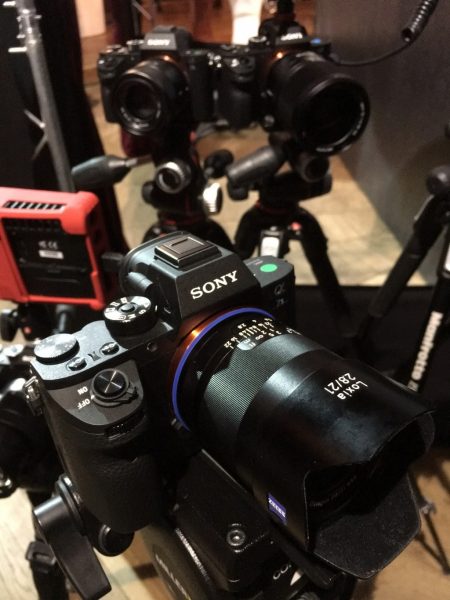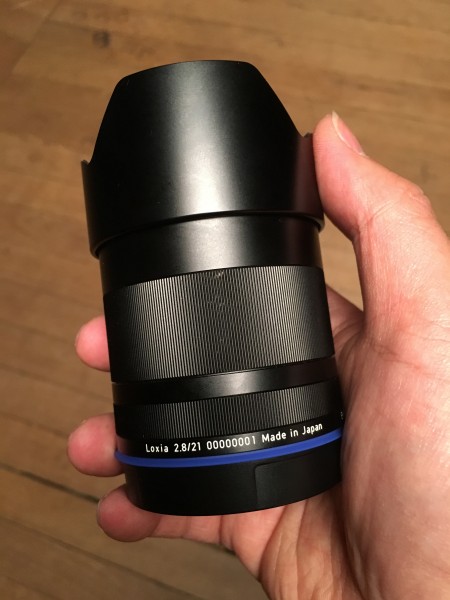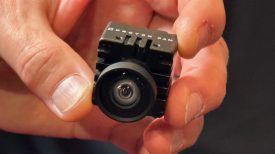By site editor Dan Chung:
At a Sony press event in Munich, Germany yesterday I had my first chance to shoot with a production a7S II. Apart from internal 4K shooting, the eagerly awaited camera has several other key improvements over the original model and one of those is higher quality 1080P HD slow motion shooting at 120 fps (100fps in PAL mode).
To do this the camera records a cropped HD image from the centre of the 12.2 megapixel full-frame sensor. Doing this allows the camera to do a full pixel readout without pixel binning. This is much better than the blurrier 120fps material recorded by the original a7S.

There are actually two high speed modes. One records the 120fps images automatically slowed in camera to 30P, 25P or 24P which can instantly be played back in slow motion in camera and should please consumers. The other is better quality, but needs to be conformed in post to play back in slow motion. When recording 120fps this way you get the full 100Mbps bit rate and most professionals will opt for this.
Using the full pixel readout allows the a7S II to create images that are more detailed and have greatly reduced moire and aliasing. Of course, using only this central portion of the sensor results in a noiser image than shooting at regular frame rates in the full-frame mode.
At the event Sony had arranged for entertainer Steve Rawlings to juggle fire. I asked him to help me make the short film above to see how the camera performs when pushed to its limits. Working in darkness, Steve was lit solely by his fire sticks.
One drawback I soon discovered was that I couldn’t record the 120fps images externally. The fastest frame rate that my Atomos Ninja Assassin could see from the camera was 1080/60P. This is a limitation of the camera and not something I expect any workaround for. Instead I opted to shoot 120fps to internal SD card in the 2.2x crop setting.
On the a7S II I used the brand new Zeiss Loxia 21mm f2.8 and the Milvus 50mm f1.4 and 100mm f2.8 macro with a Metabones EF to E-mount adapter. The crop factor for 120fps made having a wide like the 21mm Loxia essential. Bear this in mind when lensing for the camera.
Shutter speed was set at 1/250th and the picture profile was S-Log 2 with S-Gamut. The camera was set between 1600 and 6400 ISO depending on which lens was used. The results were impressive given the conditions. Noise was evident, but it was not as bad as I feared it might be. At 1600 (the base for S-Log shooting) it seemed well controlled, getting more obvious as I cranked it higher. Colour was also good considering the low light.
The Zeiss lenses handled impeccably, especially when considering that only the central part of each lens was used due to the crop factor. Focus was silky smooth and I saw no obvious aberrations on any of the lenses even though they were wide open. The 21mm f2.8 was announced only earlier this week and I was amazed to see the serial number 00000001 engraved on the barrel of the lens I was testing.

Interview audio was recorded into the a7S II using a Rode Reporter mic and Sony’s own XLR-K2M audio adapter. Having XLRs and phantom power on the camera is one of the a7 series key advantages for video journalism.
The 120fps slow motion images from the a7S II are really impressive. Image quality is very close to professional cameras like the FS7 and better than the previous compact system camera (CSC) king – the Panasonic GH4. Yes, the bit rates are limited, the 2.2x crop for better quality needs appropriate lensing, and not being able to hook up an external recorder for better compression and higher data rates is a shame, but at long last we have a viable slow motion option CSC that I would happily use on my own productions. For small brushless gimbal slomo work the a7S II will be a godsend.
Perhaps the only serious small camera competition to the a7S II comes from Sony’s own RX10 II and RX100 IV 1 inch sensor models. These have the benefit of even higher framerates than 120fps, but at reduced resolutions. The combination of smaller sensor and non-interchangeable lenses mean that the a7S II will inevitably win in low light. It will be very interesting to compare these in the future.
In our next a7S II article we will look at the differences in image between the a7S and a7S II.





